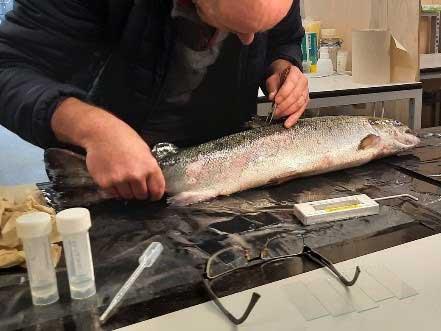
When you think about lice, you normally associate them with dogs. But did you know that salmons could have lice too? Sea lice, that is. These are parasites that typically cause infections in salmons and other farmed fish. If left untreated, they can eventually kill the salmon. And while delousing practices are common, and even mandatory in some cases, they often have a negative impact on the welfare of farmed fish or on the environment. PHOTOLICER is a project that addresses the lice problem, while avoiding the shortcomings of the current delousing methods.
The battle against sea lice is the biggest problem facing the salmon farming industry worldwide. The lice breed very quickly in the dense biomass environment of a salmon farm and their numbers grow exponentially. The damages and potential death inflicted by lice on the farmed salmons cause an estimated yearly global loss of up to €880 million, reducing dramatically the profitability of the fish farms.
Once a certain sea lice threshold in fish farms has been exceeded, regulation requires fish farmers to undertake some form of treatment. The typical method is to remove sea lice with cleaner fish (ballan wrasse and lumpfish eat the lice off the salmon) or with a range of thermal, chemical, mechanical and laser treatments. All cause problems of fish welfare or to the marine environment: use of cleaner fish creates major concerns over the increased pressure on wild stocks of those fishes. Thermal, mechanical and chemical treatments either put salmon at a high risk of a secondary infection and/or have adverse effects on the marine environment. Laser technology is effective, however it only removes one louse at a time and there can be up to 20 lice per fish in some farms.
PHOTOLICER takes a different path: the use of light as a delousing treatment. This EU-funded project works on the design and manufacture of light tubes that, as the farmed salmon passes through, exposes them to a light wavelength killing the lice without causing harm to the host salmon.
Kevin Murphy, a zoologist and Validation Scientist on PHOTOLICER project, says:
I have seen first-hand the scale of the sea lice problem. For all of my 35 years, we have tried everything, but the lice always win out. PHOTOLICER is a unique approach. We are getting excellent results in our initial tests. The biggest challenge is to scale this technology into the salmon farming environment
Atlantic Photonic Solutions Limited (APS) and UWAVE, the two partners and beneficiaries of the project, are working at optimizing the technology and reaching a final design. The first light tube will be ready in May 2022, after which they will concentrate on testing by salmon farmers and preparing for the product launch. The companies believe that their technology will be able to remove 99% of the sea lice from salmon by treating the fish for 1 second, with no adverse effects on the fish welfare and an estimated reduction of the salmon mortality to below 1% (as opposed to 8-20% when using alternative treatments). The additional advantage is that this treatment has no chemical residue, so it will have no adverse effects on the marine environment.
The potential impact of this European Maritime, Fisheries and Aquaculture Fund (EMFAF) supported project is very important. PHOTOLICER will make salmon farming more economically viable for the farmers, thus supporting a sustainable and competitive EU aquaculture. Rory Casey, from APS, underlines:
Once we get into production, we can improve the yield and output of salmon farmers – with improved fish welfare and no damage to the marine environment
At the same time, EU citizens will benefit from having a more sustainable source of protein at a more competitive cost: salmon farming is one of the most efficient food conversion systems, more efficient than poultry and much more efficient than beef production.
Did you like this story?
Then check out the April episode of Euronews OCEAN “Innovation in fisheries”
Keep informed about the project
Website
Social media
Would you like to know more about salmon farming?
Check out the EUMOFA species profile
Details
- Publication date
- 29 April 2022
- Author
- Directorate-General for Maritime Affairs and Fisheries




